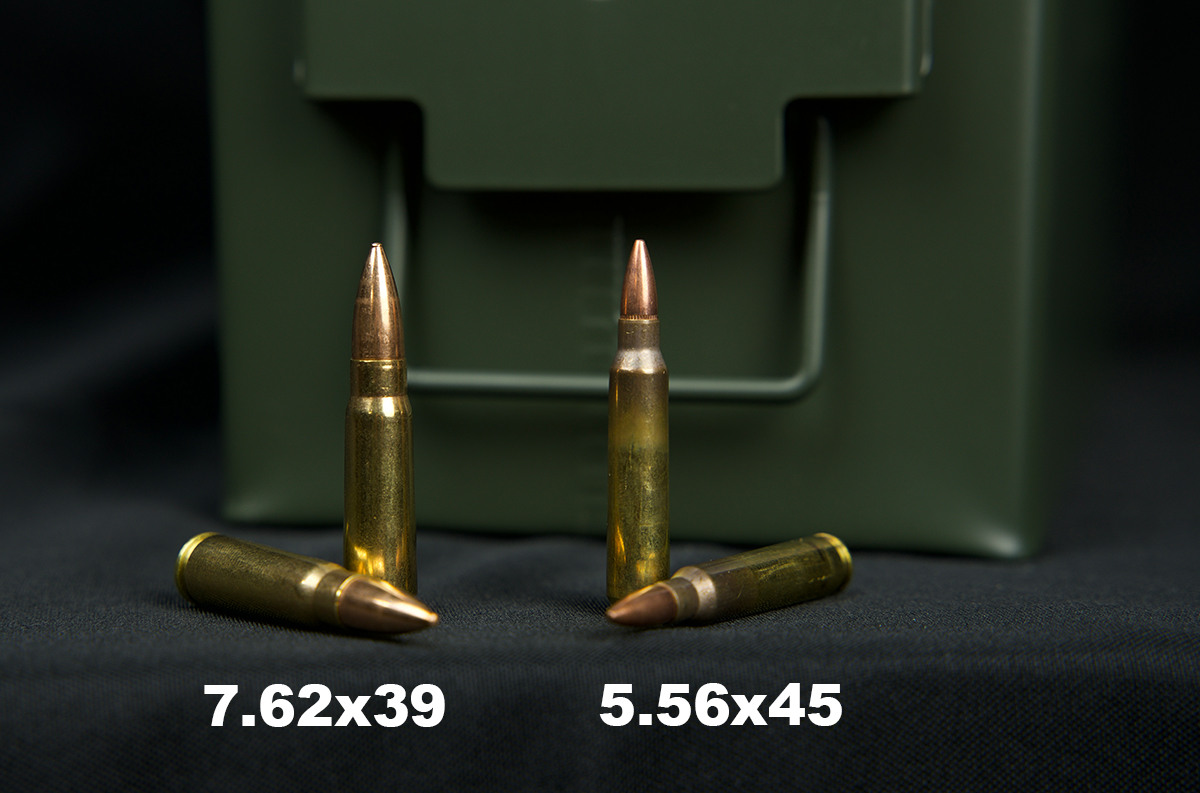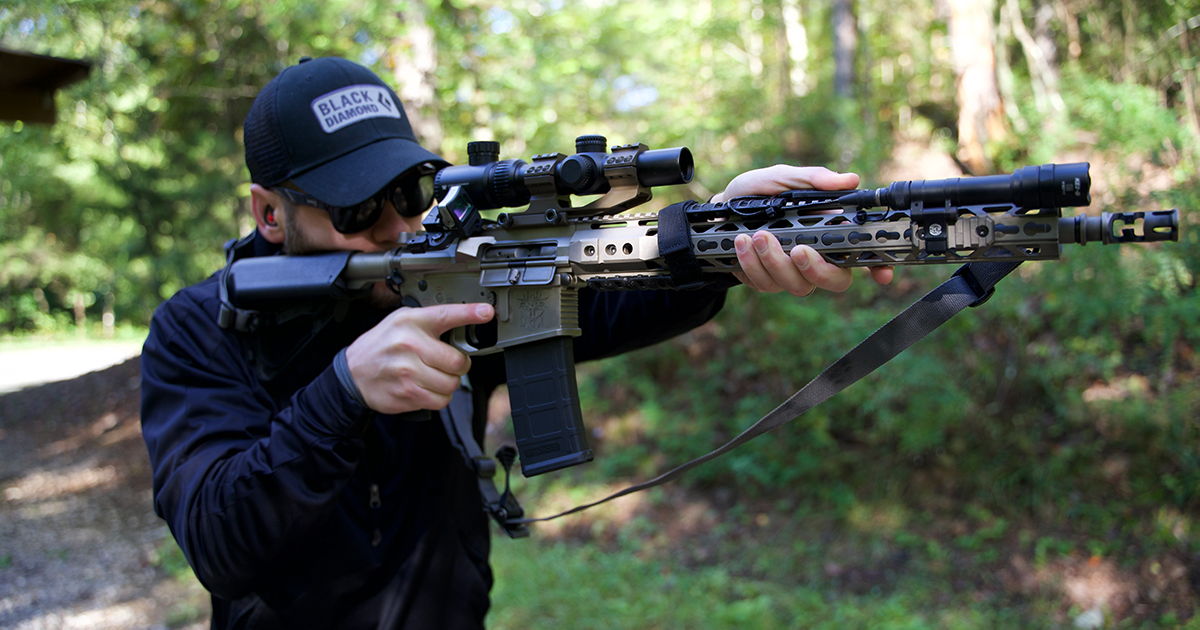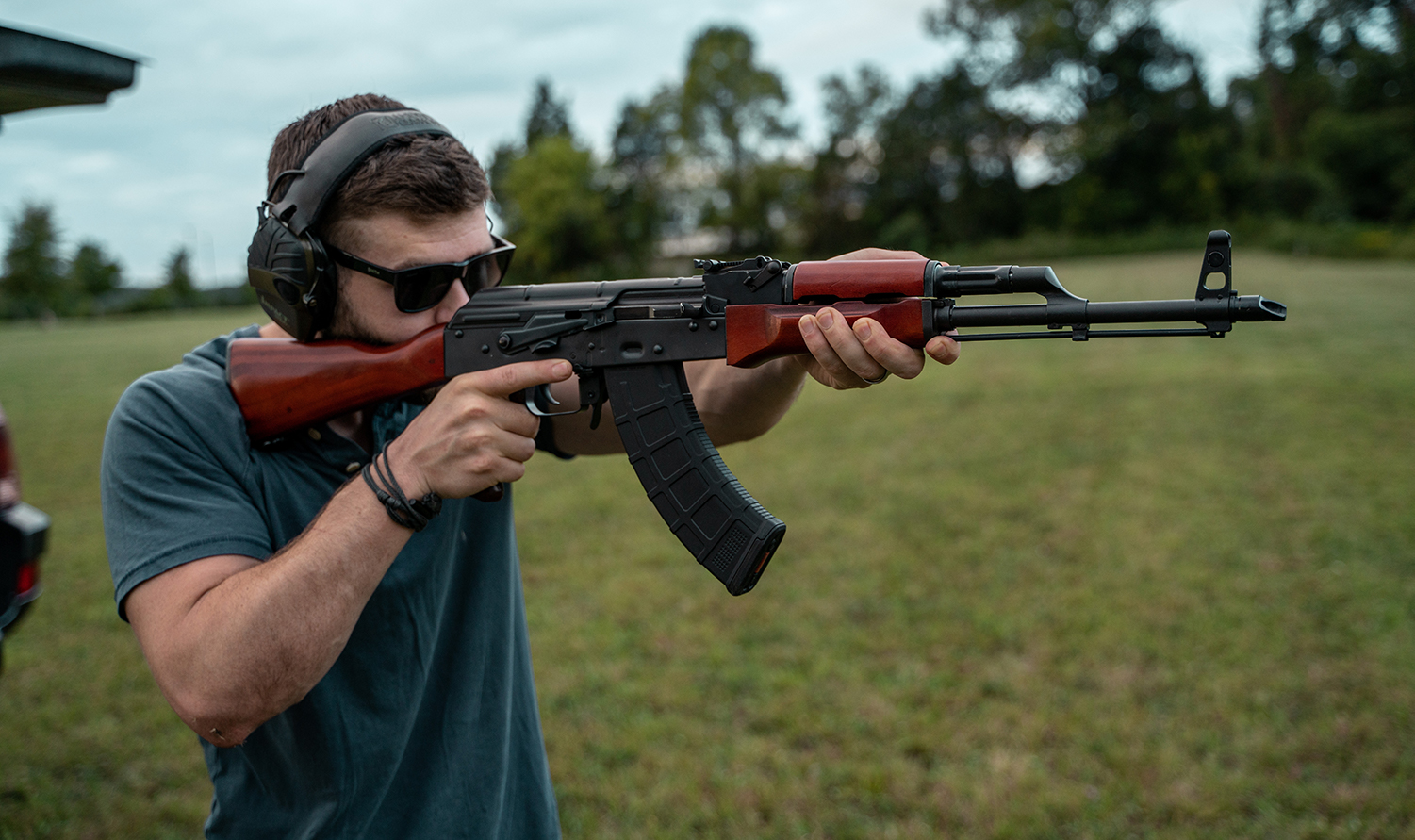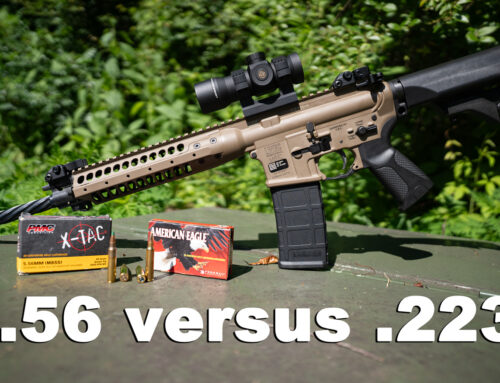No two rifle cartridges demand comparison more than 7.62×39 vs 5.56. One is America’s favorite rifle cartridge; the other is Russia’s pride and joy, but hugely popular stateside nonetheless.
Ammo doesn’t have politics and nationalities. We judge a round solely on the quality of its in-flight ballistics, energy, recoil, and price and availability. That’s why we’re going to compare those qualities in order to settle the 5.56×45 vs 7.62×39 debate – if it can be settled at all.
Most articles like these begin with long-winded histories of the two rounds they’re comparing. We know there are a thousand other places where you can read up on Remington or the Technical Council of the People’s Commissariat for Armaments, so we’re going to spare you a lecture. Let’s jump right into things by taking a look at these two cartridges’ dimensions side by side.
Cartridge Dimensions

| 5.56x45 | 7.62x39 | |
|---|---|---|
| Case type | Rimless, bottleneck | Rimless, bottleneck |
| Bullet diameter | 0.224 in | 0.309-0.311 in |
| Neck diameter | 0.253 in | 0.339 in |
| Shoulder diameter | 0.354 in | 0.396 in |
| Base diameter | 0.377 in | 0.447 in |
| Rim diameter | 0.378 in | 0.447 in |
| Rim thickness | 0.045 in | 0.059 in |
| Case length | 1.760 in | 1.524 in |
| Overall length | 2.260 in | 2.205 in |
| Case capacity | 28.5 gr H2O | 35.6 gr H2O |
| Maximum pressure | 62,366 psi | 45,010 psi |
The obvious difference between the 5.56 and the 7.62 is their bullet diameters. The former is a .22 caliber round, while the latter is a .30 cal. This has big implications for their bullet weights. The 5.56 typically has a 55 grain bullet, although bullets weighing 40, 62, and 77 grains are not uncommon. Its greater diameter means the 7.62 bullet can weigh substantially more – usually 123 grains or very close to it.
Next consider the two rounds’ case capacities – not terribly different from one another, so they can store similar propellant charges. And considering that the 5.56 is loaded to a higher pressure, it only follows that its lighter bullet should deliver a greater muzzle velocity. That’s just physics, folks.
Ballistics Comparison
7.62×39 vs 5.56: Muzzle Velocity

| 5.56 - Federal American Eagle 55gr FMJBT | 7.62x39 Federal American Eagle 124gr FMJ | |
|---|---|---|
| Muzzle velocity (fps) | 3165 | 2350 |
| Velocity @ 50 yds | 2966 | 2213 |
| Velocity @ 100 yds | 2777 | 2081 |
| Velocity @ 150 yds | 2596 | 1953 |
| Velocity @ 200 yds | 2421 | 1831 |
| Velocity @ 250 yds | 2253 | 1714 |
| Velocity @ 300 yds | 2092 | 1603 |
| Velocity @ 350 yds | 1938 | 1499 |
| Velocity @ 400 yds | 1791 | 1402 |
| Velocity @ 450 yds | 1653 | 1312 |
| Velocity @ 500 yds | 1523 | 1233 |
| 5.56 - Sellier & Bellot 55gr FMJBT | 7.62x39 Sellier & Bellot 124gr FMJ | |
| Muzzle velocity (fps) | 3301 | 2421 |
| Velocity @ 50 yds | 3103 | 2274 |
| Velocity @ 100 yds | 2914 | 2132 |
| Velocity @ 150 yds | 2733 | 1995 |
| Velocity @ 200 yds | 2560 | 1864 |
| Velocity @ 250 yds | 2393 | 1738 |
| Velocity @ 300 yds | 2232 | 1619 |
| Velocity @ 350 yds | 2077 | 1508 |
| Velocity @ 400 yds | 1929 | 1404 |
| Velocity @ 450 yds | 1787 | 1310 |
| Velocity @ 500 yds | 1653 | 1227 |
The 5.56 is a speed demon, often loaded to muzzle velocities in excess of 3,200 fps. The 7.62 is no slouch in terms of velocity either, although its bullet typically exits the muzzle at a rate 20 to 25 percent slower than the 5.56.
The 7.62 rounds we compared all have higher ballistic coefficients than the 5.56 ones, meaning they are able to retain relatively more of their initial velocity as they hurtle downrange. But that’s just not enough to make the 7.62’s trajectory nearly as flat as the 5.56. The 5.56’s lighter, faster bullet gives gravity far less time to pull it down to earth, so it’s bound to evince less drop than its competition.
Trajectory
| 5.56x45 Federal American Eagle 55gr FMJBT | 7.62x39 Federal American Eagle 124gr FMJ | |
|---|---|---|
| G1 ballistic coefficient | 0.25 | 0.303 |
| G7 ballistic coefficient | 0.126 | 0.163 |
| Elevation @ 50 yds | 0.04 | 0.86 |
| Elevation @ 100 yds | 0.58 | 1.44 |
| Elevation @ 150 yds | 0 | 0 |
| Elevation @ 200 yds | -1.88 | -3.71 |
| Elevation @ 250 yds | -5.24 | -10.03 |
| Elevation @ 300 yds | -10.32 | -19.3 |
| Elevation @ 350 yds | -17.39 | -31.96 |
| Elevation @ 400 yds | -26.78 | -48.5 |
| Elevation @ 450 yds | -38.88 | -69.47 |
| Elevation @ 500 yds | -54.17 | -95.48 |
| 5.56x45 Sellier & Bellot 55gr FMJBT | 7.62x39 Sellier & Bellot 124gr FMJ | |
| G1 ballistic coefficient | 0.259 | 0.286 |
| G7 ballistic coefficient | 0.127 | 0.143 |
| Elevation @ 50 yds | -0.05 | 0.77 |
| Elevation @ 100 yds | 0.49 | 1.34 |
| Elevation @ 150 yds | 0 | 0 |
| Elevation @ 200 yds | -1.65 | -3.53 |
| Elevation @ 250 yds | -4.63 | -9.57 |
| Elevation @ 300 yds | -9.13 | -18.49 |
| Elevation @ 350 yds | -15.38 | -30.73 |
| Elevation @ 400 yds | -23.65 | -46.8 |
| Elevation @ 450 yds | -34.26 | -67.28 |
| Elevation @ 500 yds | -47.59 | -92.82 |
The 5.56’s flatter trajectory makes it easier to aim over longer ranges. You’re certain to have better success with the 5.56 for long-distance shooting, especially given the 7.62’s tendency to begin dropping off steeply past the 200 yard mark. But both the 5.56 and 7.62 are plenty accurate at ranges within 100 yards, a distance which most shooters would stay within at the rifle range anyway. Neither one is a sniper round!
Energy
| 5.56x45 Federal American Eagle 55gr FMJBT | 7.62x39 Federal American Eagle 124gr FMJ | |
|---|---|---|
| Muzzle energy (ft lbs) | 1224 | 1521 |
| Energy @ 50 yds | 1075 | 1349 |
| Energy @ 100 yds | 942 | 1192 |
| Energy @ 150 yds | 823 | 1051 |
| Energy @ 200 yds | 716 | 923 |
| Energy @ 250 yds | 620 | 809 |
| Energy @ 300 yds | 535 | 708 |
| Energy @ 350 yds | 459 | 619 |
| Energy @ 400 yds | 392 | 541 |
| Energy @ 450 yds | 334 | 474 |
| Energy @ 500 yds | 283 | 419 |
| 5.56x45 Sellier & Bellot 55gr FMJBT | 7.62x39 Sellier & Bellot 124gr FMJ | |
| Muzzle energy (ft lbs) | 1331 | 1614 |
| Energy @ 50 yds | 1176 | 1423 |
| Energy @ 100 yds | 1037 | 1251 |
| Energy @ 150 yds | 913 | 1096 |
| Energy @ 200 yds | 800 | 956 |
| Energy @ 250 yds | 699 | 832 |
| Energy @ 300 yds | 608 | 722 |
| Energy @ 350 yds | 527 | 626 |
| Energy @ 400 yds | 454 | 543 |
| Energy @ 450 yds | 390 | 473 |
| Energy @ 500 yds | 334 | 414 |
The 5.56 may have its competition beat in terms of muzzle velocity, yet the 7.62’s bullet compensates for that by weighing about 2 to 2.5 times more. This means it boasts superior energy at all ranges.
Selecting a round for self-defense? Then you don’t really have to worry about which one is more powerful. Either the 7.62 or 5.56 will overwhelm a human-sized target at close range, so the 7.62’s 20 to 25 percent greater muzzle energy doesn’t necessarily mean it will more effectively neutralize a threat. Its wider bullet will carve out a bigger wound channel, however, so its terminal effect does tend to prove a bit more harmful. Icing on the cake, so to speak.
For deer hunting the more powerful 7.62 tops the 5.56. The consensus is that 1,000 ft lbs is the minimum required energy for ethical deer hunting. A 5.56 often fails to transfer that much energy at 100 yards, while the 7.62 can easily extend a hunter’s reach past 150 yards. But it’s important to keep in mind that both rounds were developed for shooting enemies of their respective states of origin, not hunting.
Recoil of 7.62×39 vs 5.56

Recoil is important, friends. We admit it’s thrilling to fire a weapon that kicks like a mule on bath salts, but you wouldn’t want to put up with that kind of abuse all day long. What’s more, heavy recoil complicates self-defense. The more recoil a rifle generates, the more each shot will throw off your carefully lined up aim.
At the end of the day, the amount of recoil you actually perceive is subjective. We can’t quantify what you actually feel. What we can do is objectively measure a cartridge’s recoil energy by considering four factors: bullet weight, propellant weight, muzzle velocity and rifle weight.
Let’s do a real apples-to-apples comparison of the above rounds’ recoil energy. For the sake of this exercise lets assume all six rounds have 24 grains of propellant. We’re firing the 5.56 in a 7.75 lb Windham Weaponry Dissipator Hvy. Bbl and the 7.62 in a 7.7 lb AK-47.
| Recoil Energy (ft lbs) | |
|---|---|
| 5.56x45 Federal American Eagle 55gr FMJBT | 3.54 |
| 5.56x45 Sellier & Bellot 55gr FMJBT | 3.72 |
| 5.56x45 Nosler SSA 55gr Ballistic Tip | 2.95 |
| 7.62x39 Federal American Eagle 124gr FMJ | 6.97 |
| 7.62x39 Sellier & Bellot 124gr FMJ | 7.27 |
| 7.62x39 Nosler 123gr Ballistic Tip | 6.97 |
The 7.62 might have about 75 percent of the 5.56’s muzzle velocity, but its far heavier bullet makes it deliver about twice as much recoil. It’s important to consider that we picked a relatively heavy AR for the purpose of this comparison. Heavier gun equals less recoil, so if we fired the Federal round in a 6.5 lb Ruger AR-556 its recoil energy would be higher at 4.22 ft lbs – but that’s still less kick than the AK.
To be certain, neither round produces an inconvenient amount of recoil. A normal sized shooter could fire an AK all day long and never get tired of it – and many do. But if you demand lower recoil for your own comfort or to make it easier to direct rapid, accurate fire at a threat, then you’d want the 5.56.
Availability & Price
Assuming the ammo market hasn’t gone bazooey in reaction to some impending apocalypse, finding either 7.62×39 ammo or 5.56 is easy as pie. Put on a blindfold, walk into a gun store, and you’re sure to find both types of ammo. (The store clerks will probably think you’re weird if you do that, so put on a blindfold and shop for ammo on our site instead. Be sure to have an explanation ready for your wife when you wind up blindly ordering 38 cases of blank 22 Short ammo.)
The two rounds also cost about the same. But here’s the thing: While AR owners often note extraction issues when they fire steel-cased 5.56, the AK’s forgiving tolerances enable it to run steel-cased 7.62 with practically zero issues. In a nutshell, by preferring 7.62 you get to take full advantage of all that budget-friendly steel-cased Russian ammo, while it is available. It’s not reloadable, it shoots a little dirtier, and its bullets are magnetic, but hey – you can save a lot of dough with an AK!
The Takeaway: 7.62×39 vs 5.56
The 5.56 offers slightly superior accuracy and lighter recoil. The 7.62 delivers greater energy on impact as well as the opportunity to take better advantage of the cost saving power of steel. It’s a close race, but we’ve overlooked the deciding factor in the 5.56×45 vs. 7.62×39 debate: the rifles.
There are several rifles available chambered for 5.56 ammo, and they will all let you fire nearly identical 223 Rem ammo as well. The most popular of these rifles really nearly begs no mention. When you embrace the 5.56 you get to have fun with the AR-15. It’s endlessly customizable, as cheap or expensive as you want it to be, and extremely reliable. Americans haven’t chosen so practical a rifle as their very favorite because they don’t understand guns.
By comparison the AK-47 isn’t remotely customizable. You can affix a bayonet to it or even give it a rather awkward scope mount if you feel like Mikhail Kalashnikov left something out, but other than that an AK is meant to stay the way it is. Alternatively you could get an SKS instead, but that’s by no means a gun modder’s dream rifle either.
Yet the AK has its blessings. You can get a real workhorse for about $500, and you can abuse the absolute heck out of it before it thinks about jamming up on you. And this may sound biased, but the AK is a very handsome rifle. There’s a certain charm to walnut that polymer will never match.
If you’re on the fence, try out an AR-15 and then an AK-47. See which one you like more, and then decide whether you prefer the 5.56 or 7.62 based solely on that.
Don’t like either rifle? Consider learning kung fu.






Front door AR-15…Back door AK-47. In between randomly placed pistols…and a snack.
Sounds like a plan to me. Let me know if you ever are in need of a room-mate!
Someone mention “snack”? What caliber?
Romanian SKS for me… I’ve 9 of ’em… purchased back in the good old days before the internet… with a C&R license they cost you a shade over $100… good times!
You can call it AK-47 if you want but that’s an AKM.
Fair enough –
Have you ever done a comparison of an AK 47, an AR 15 and thrown in the Mini 14 and/or Mini 30 into the mix?
I’d just like to get your thoughts on the Rugers.
Enjoyed the above on the 5.56 vs 7.62, Thanks